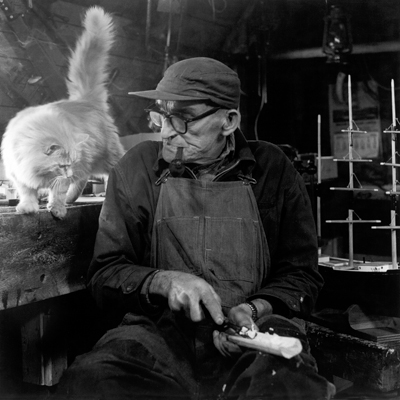The missing rake
Peter Barss, at yesterday's opening of his rescued Images of Lunenburg County at the Anderson Gallery:As you look at these pictures and read the text panels from the book I imagine you’ll be asking yourselves the same question that has perplexed me for years: how did these men survive... without Wal-Mart?The show is up until August 4. After the jump, Peter describes the work a Halifax design shop put in restoring the images, the negatives for which had been lost in a house fire a quarter century ago:Right after Myra and I were married we spent a few nights in the West Ironbound lighthouse with our friends Ingram and Lynn Wolf, the light keepers on the island. One evening Ingram set out to rake up some grass but couldn’t find his rake. So he made one. Drilled some holes in a narrow board, whittled wooden pegs for the teeth, and walked into the woods to cut a sapling for a handle. Ingram had the grass raked up before the sun set. That memory has remained with me as emblematic of the self-sufficiency and resourcefulness of the people represented in this exhibit, If I had needed a rake it would never have occurred to me that I could make one. I would have headed directly to the hardware store. These men could fix anything that went wrong with the engines in their boats with nothing more than a screw driver and a pair of pliers, they navigated through fog as thick as pea soup, and they could tell you what the weather would be in coming days more accurately than the forecasters of today who seem to believe that staring at computer screens will give them more information than stepping outside and learning what nature has to tell them. These men lived at a time when communities were relatively isolated, families were closer and people had more time for each other. Neighbors depended on neighbors in good times and bad times. There were community dances and parties and when men were lost at sea --which happened all too frequently--the entire village grieved with the family. They were not rich men and they didn’t own a lot of stuff. But they were only poor in an economic sense. One man told me “I remember back... there was nice feelings in them times. We had nothin’... but you was a millionaire.” It’s easy to romanticize the era this exhibit portrays. No one wants to go back to those days... but maybe we should look back and think about what we have lost.
04 July, 2010


